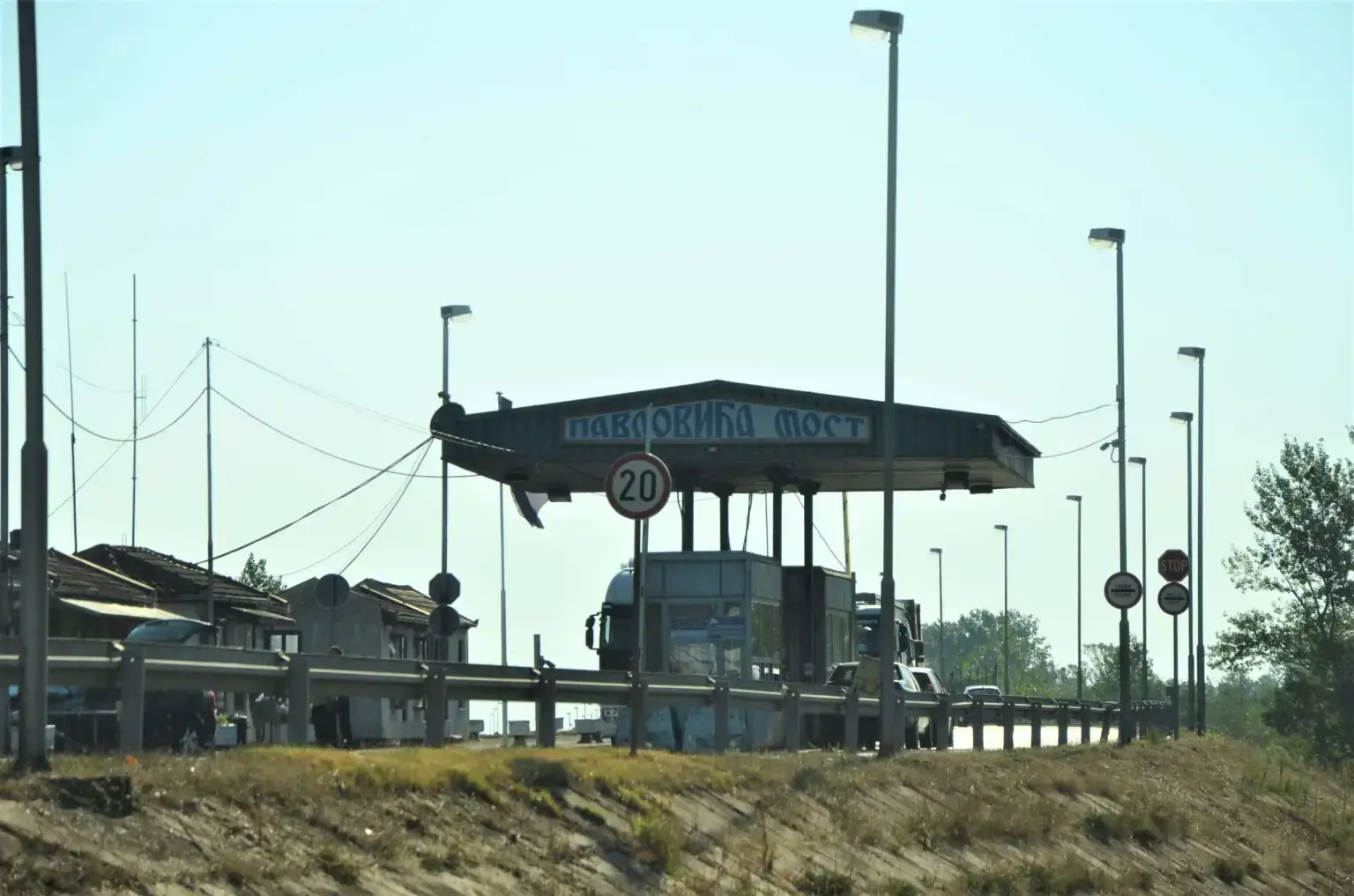The construction of the Pavlović bridge is among the first examples of public-private partnerships in Serbia after the Law on Concessions was passed. On the basis of this law, the Government of Serbia concluded a concession contract for the construction of a bridge on the Drina between Serbia and Bosnia and Herzegovina for a period of 30 years with a non-resident from the USA (Chicago), and through the company Drina River Bridge Corporation A.D. The contract expires in 2025, and until then the company Drina River Bridge Corporation A.D. has the right to charge the bridge toll in the amount determined by the Government of Serbia.
Self-proclaimed Serbian benefactors Slobodan and Mira Pavlović started the construction of a bridge over the Drina River in the early 1990s with the aim of connecting the people of Semberija (BiH) and Mačva (Serbia).
After the signing of the Dayton Peace Agreement, the construction of the Pavlović Bridge was completed in 1996. The bridge became a border crossing between two independent and sovereign states – Bosnia and Herzegovina and Serbia, but also the only bridge on the border/s where tolls have been charged for decades. In 1996, Pavlović also laid the foundation stone for the construction of the new town of Slobomir, in the immediate vicinity of the Pavlović Bridge, where Slobomir P University and Slobomir Radio and Television are located today.
Shown business results
According to the available documentation, the Pavlović bridge is managed by the company Drina River Bridge Corporation A.D. with headquarters in Belgrade, and at one time there was also a branch in the village of Popovi near Bijeljina (BiH). For a company that has multimillion-dollar revenues every year, it is indicative that none of the available phone numbers are active, which fuels doubts about the transparency of the work they do and the money that flows into who knows whose pockets.
According to the available data, the construction of the “philanthropist” bridge of Slobodan and Miro Pavlović cost about 4.2 million US dollars, and the collection of tolls for all these years, according to rough estimates, collected tens, perhaps even hundreds of millions of KM.
Total revenues in 2019 amounted to 105,871,000 Serbian dinars or about 1.7 million KM. In 2020, due to the coronavirus pandemic, revenues fell to 74,497,000 dinars or 1.2 million KM, but last year’s revenues exceeded all previous years and amounted to 118,333,000 dinars or 1.97 million KM.
If we look at the ratio of income over expenses, the company Drina River Bridge Corporation A.D. has “net profits” of 575,000 KM in 2019, 267,416 KM in 2020 and 643,633 KM in 2021. So, for the last three years, the profit from the collection of bridge tolls amounted to 1.5 million KM. At least that’s how it’s shown in the available documentation.
By looking at the basic data of the Drina River Bridge Corporation Akcionarsko društvo Beograd (Novi Beograd), Miroslava Pavlović was registered as the owner, on two bases with a share of 60.95 per cent and 34.37 per cent, and Nenad Glišić with 0.57 per cent of the capital. According to the same documentation, the representative of the company is Radomir Jovanović (director), while the procurators are Mile Pavlović and Vanja Ćosović. It was also stated that the company was founded on June 25, 1991.
Public-private partnership
The construction of the Pavlović bridge/bridge is among the first examples of public-private partnership in Serbia, and after the Law on Concessions was passed. On the basis of this law, the Government of Serbia concluded a concession contract for the construction of a bridge on the Drina between Badovinac (Serbia) and Popov (BiH) with a non-resident from the USA (Chicago), and through the company Drina River Bridge Corporation A.D., for a period of 30 years.
The contract expires in 2025, and until then the company Drina River Bridge Corporation A.D. has the right to charge the bridge toll in the amount determined by the Government of Serbia. After the contract expires, the bridge returns to the ownership of the Republic of Serbia. And that’s where the circle closed, but…
Where is the state of Bosnia and Herzegovina in the whole story? It was at this stretch that the Drina river once changed its course, leaving the land owned by the local Badovina people (Serbia) on the left bank (Bosnia and Herzegovina side).

On the day of mutual recognition of BiH and Serbia, the border between the two countries was identified in the middle of the Drina river. Never after that have the Commission for the Borders of BiH and Serbia agreed and ratified the agreement on the border. Although there were hints that after the ten-year abstinence, the members of the aforementioned commissions would sit down at the negotiating table again, this did not happen. The Serbian Border Commission has identified four disputed points near the Zvornik and Bajna Bašta hydropower plants and the Belgrade-Bar railway.
Disputed points in the region of Bogatić (Serbia) and Janja (BiH), due to the change in the course of the Drina Rive,r were not considered, which leaves room for, for example, illegal exploitation of gravel, smuggling of oil derivatives and high-excise goods and other forms of crime.
Installation of boards
The board with the inscription “Opština Bogatić” has long since moved from the right to the left bank of the Drina, and recently the inscription “Serbia” was also placed on the board that was placed on the left bank, two kilometres from the Pavlović bridge on the territory of Bosnia and Herzegovina. Passengers who enter Bosnia and Herzegovina from Serbia via the Pavlović bridge have a notification that they are in the territory of Bosnia and Herzegovina in only one place, and travellers who enter Serbia from Bosnia and Herzegovina have a sign with the inscription “Serbia” two kilometres before the Pavlović bridge. The Republic of Serbia has never in history been on both the right and left banks of the Drina in that area, but…
And while Serbia has largely overrun the Drina and crossed over to the left bank right at the Pavlović bridge, the residents of Janja, ten kilometres away, can only look at their properties in Serbia. From a cadastral point of view, the land belongs to the City of Bijeljina/Janja, but de-facto, according to international regulations, it is located in Serbia, because the border between the two countries is currently established in that area in the middle course of the Drina river.

On the other hand, the residents of Badovinac immediately after the Pavlovic bridge placed a sign with the inscription: “The way to the property of the citizens of Badovinci. Cadastral municipality of Badovinci – Serbia” and, of course, on the left bank of the Drina.
The circumstances of “no man’s land” or the unrefined border agreement are used for different purposes, and the Pavlović bridge, which was built under the guise of connecting Semberija and Mačva, fits perfectly into the mosaic of lawlessness. And everyone is silent about it. In BiH, there is no reaction at all to the fact that Serbia ran over the Drina and that a board with the inscription “Srbija” was placed on the left bank. At the same time, in Serbia, they are wisely silent and the land around the Pavlović bridge, that is, the Drina river, is used for the exploitation of gravel and the destruction of the river bed, which is why floods threaten the surrounding villages.
Stop the bridge toll collection
Ordinary citizens resent it. That’s why they created a Facebook group with the name: “Stop collecting bridge tolls on the Pavlović bridge”, but there was no effect.

We contacted the administrator of the group, who wrote on Facebook: “I live in Šabac and work in Bijeljina, every day I pay 320 dinars (5.3 KM) to cross the Pavlović Bridge and have been doing so for 4 years. I set aside one salary per year just for the bridge. I am asking you to persevere together and abolish this tribute!”.
He did not answer our questions, and his last post on the aforementioned Facebook group reads:
“According to the data of the State Border Service of Bosnia and Herzegovina, 27,355 cars, 3,820 trucks and 484 buses crossed the Pavlović Bridge in one month. According to the valid price list, the company “Drina River Bridge”, which manages this bridge, earned about 140,000 KM in just one month on bridge tolls,” he wrote.
We tried to verify his allegations at the company Drina River Bridge Corporation A.D., based in Belgrade, but, as we have already written, their phones are not working.
Slobodan Pavlović died in a traffic accident in Chicago at the end of 2021. Before the fatal traffic accident, Pavlović’s empire began to crumble. They privatized Bijelji’s “Žitopromet”, but without success. “Pavlović Bank” also failed, and currently Slobomir P University, radio, and television are active…
Until 2025, the Drina River Bridge company will collect tolls on the Pavlović Bridge, and then the building of Slobodan and Mira Pavlović will pass into the hands of the Republic of Serbia. What will happen to the land and the access roads in and around the bridge, whether an agreement will be reached on the border and the border zone, is difficult to predict, but without international arbitration, it is difficult to expect that the Commissions for the Borders of BiH and Serbia will agree on the disputed points, among which is also the Pavlović Bridge.
(Interview)






